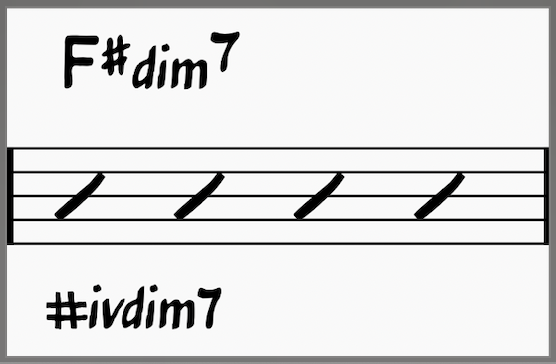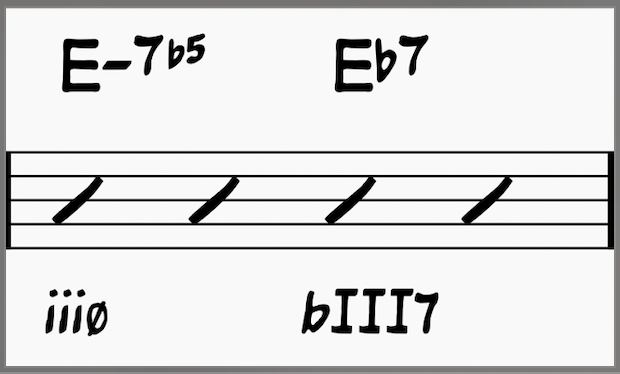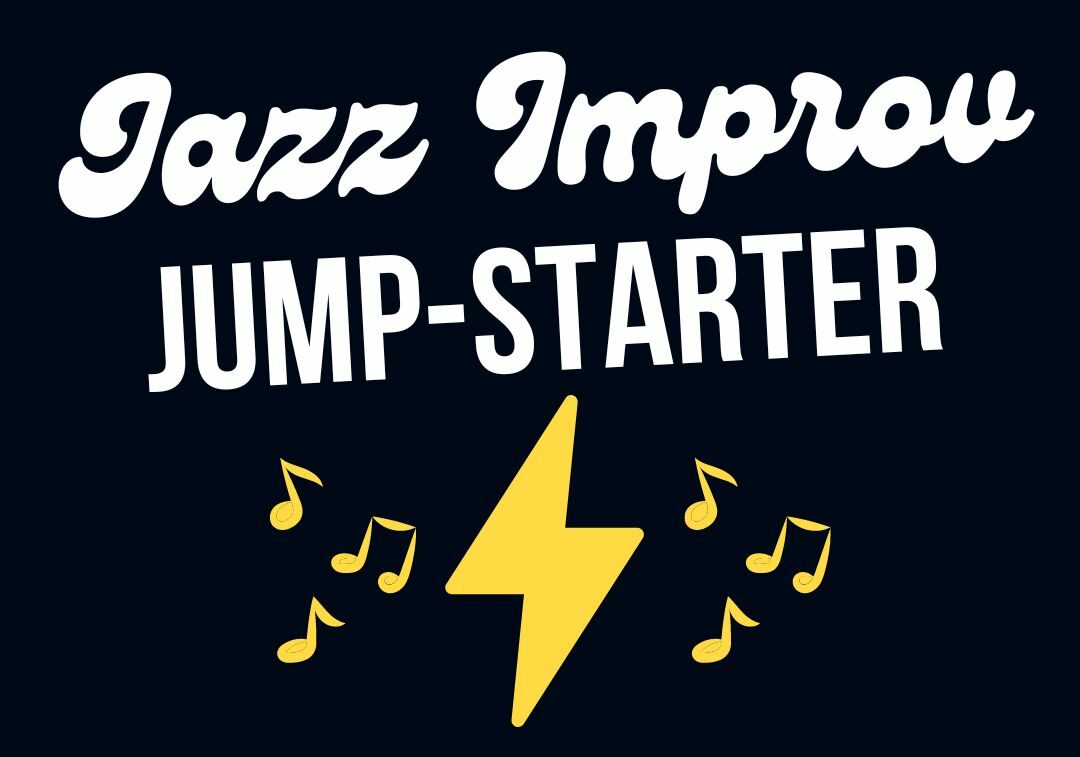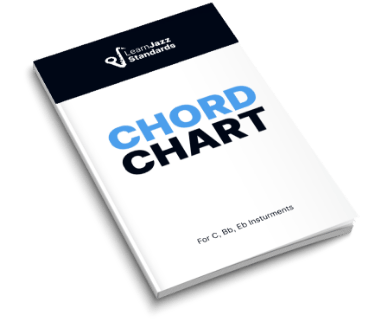Jazz chord progressions don’t have to be confusing.
Many players who want to learn jazz music feel overwhelmed when they try to analyze jazz chord progressions and understand how they work. Because jazz chord progressions and jazz chords are harmonically complex, many musicians shy away from learning how to understand and wield them.
However, with the right approach, you can master any jazz chord progression, regardless of its harmonic richness.
We’ll start with basic jazz chord progressions and then move on to chord substitutions and other common jazz progressions. From the jazz blues, bossa, and waltzes to rhythm changes, the following chord progressions will help you master every jazz song you encounter.
And, if you are looking to seriously upgrade your jazz playing skills, you should check out the Learn Jazz Standards Inner Circle. The Inner Circle helps players like you take your jazz playing and music theory comprehension to the next level.
Improve in 30 days or less.Join the Inner Circle.
Why Learn These Nine Jazz Chord Progressions?
Most jazz songs are constructed with the same handful of common jazz chord progressions. Though the keys and arrangements of these jazz chord progressions differ from song to song, the individual pieces are roughly the same.
It’s kind of like Legos. Every jazz song is made of smaller chord progressions, which create that specific jazz song when arranged in a certain way. By learning common jazz chord progressions (smaller Lego pieces), you can learn virtually any jazz standard (Lego castles).
Each new chord progression you learn can also be found in literally hundreds of other jazz songs because jazz uses many similar chord progressions.
The main takeaway is that to master jazz, you need to understand basic jazz chord progressions—If your goal is to become an expert at playing solos over jazz tunes or comping through jazz changes, you must understand how jazz chord progressions function.
What You’ll Need To Know Already
You’ll want to already have two music theory items under your belt before tackling full jazz chord progressions.
They are:
- Common Jazz Chords
- Roman Numerals in Music
If these concepts are new, I recommend reading through the next section. However, if you are no stranger to them, please use the Table of Contents to jump right to the jazz chord progressions.
Common Jazz Chords
Jazz music is mainly comprised of 7th chords. 7th chords are four-note chords that include a root note, a third, a fifth, and a seventh.
There are four main types of diatonic seventh chords:
Major Seventh chords:

- Major Seventh: B
- Perfect Fifth: G
- Major Third: E
- Root Note: C
Dominant Seventh chords
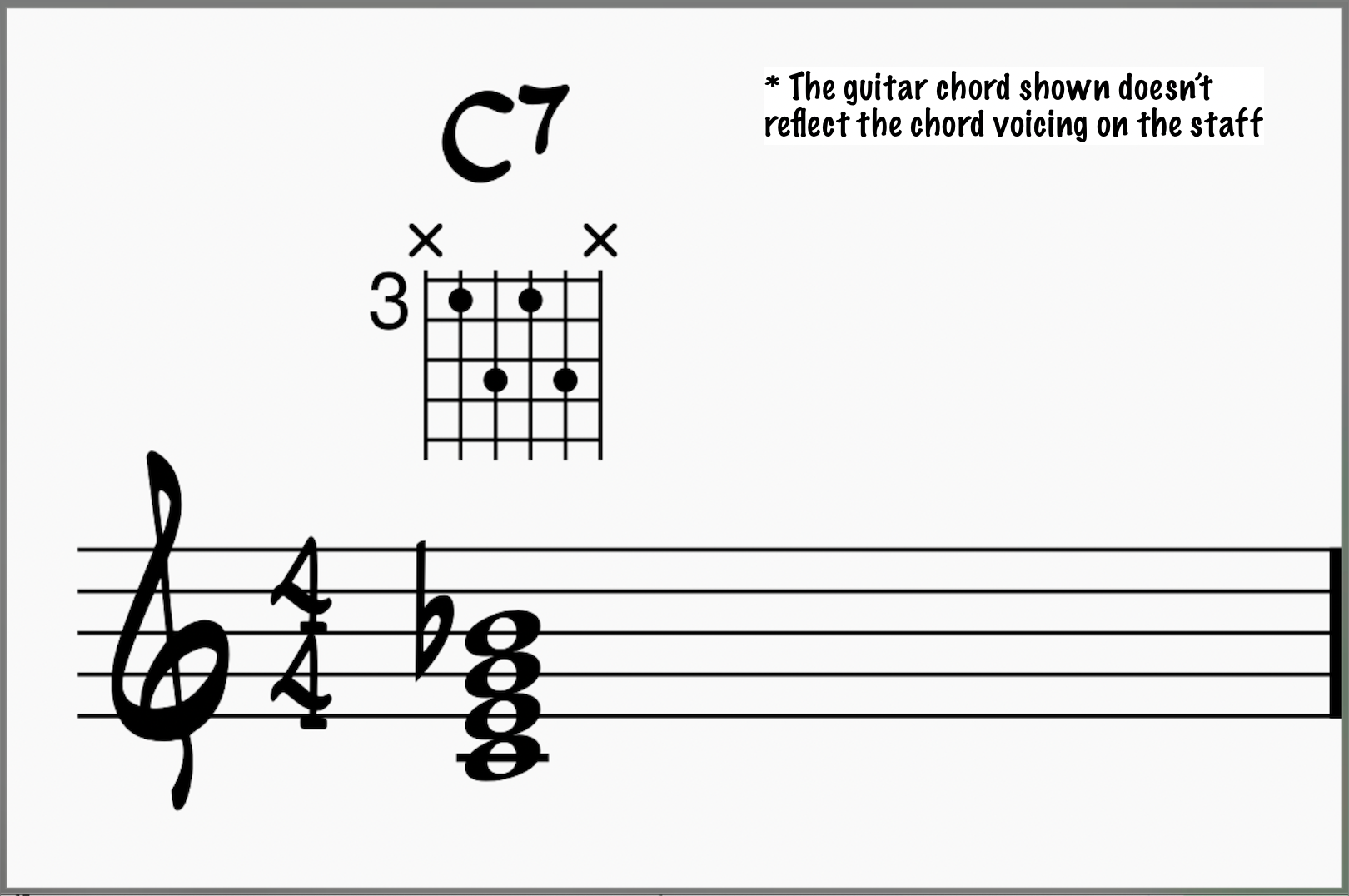
- Minor Seventh: Bb
- Perfect Fifth: G
- Major Third: E
- Root Note: C
Minor seventh chords
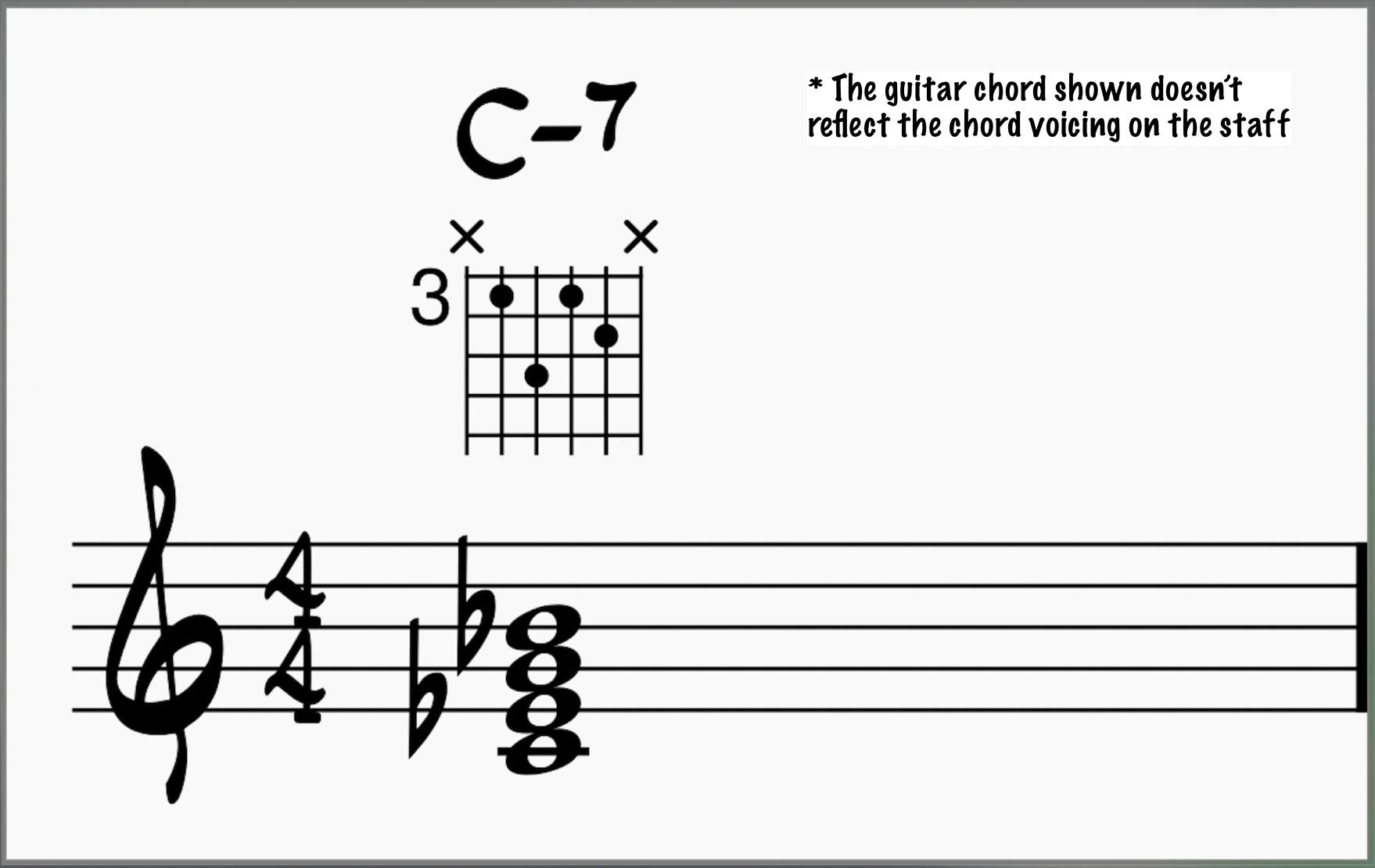
- Minor Seventh: Bb
- Perfect Fifth: G
- Minor Third: Eb
- Root Note: C
HAlf-diminished seventh chords
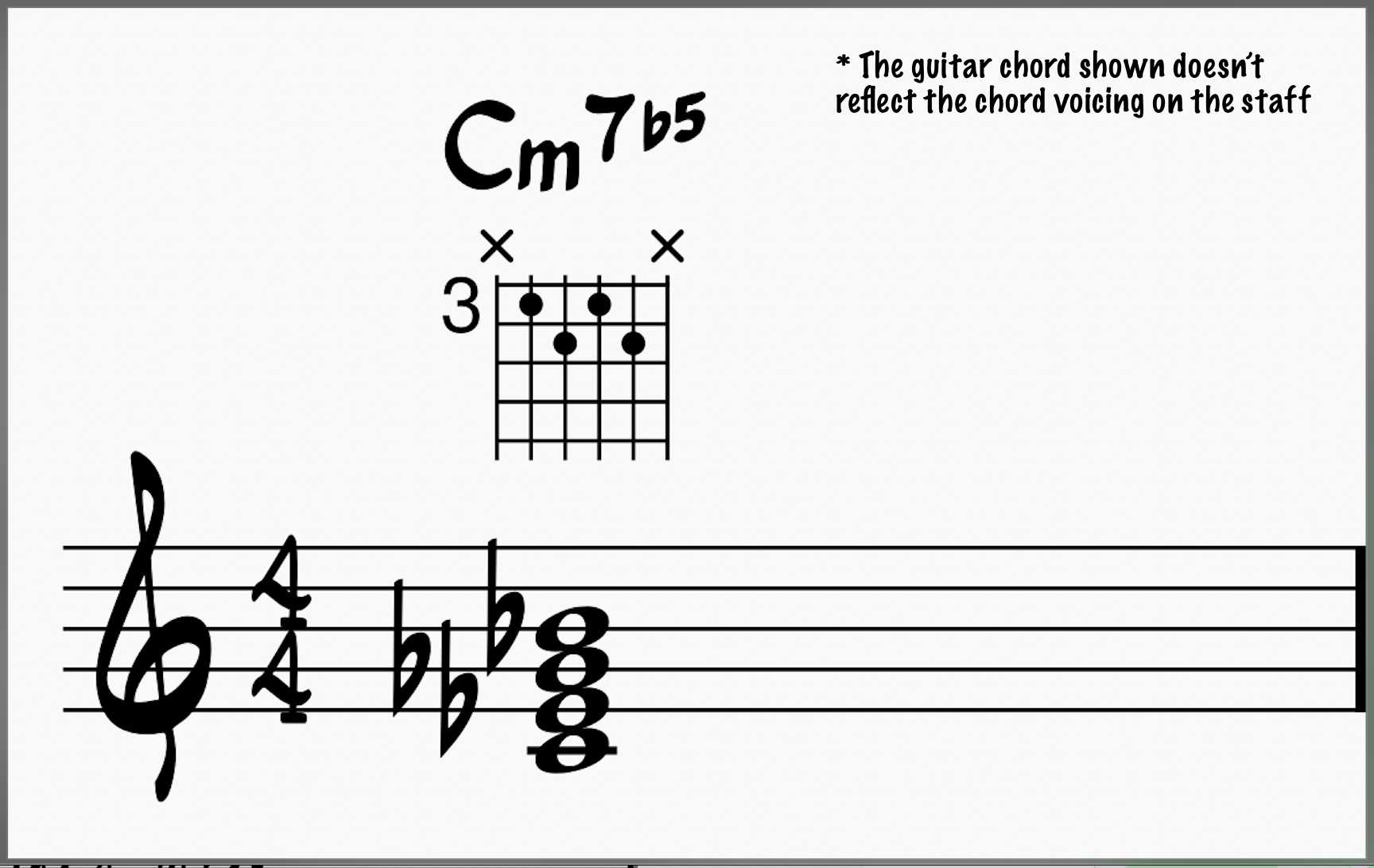
- Minor Seventh: Bb
- Diminished Fifth: Gb
- Minor Third: Eb
- Root Note: C
There are other types of jazz chords beyond these, like extended chords, altered chords, and non-diatonic seventh chords. However, you can play most jazz tunes by learning these four chords.
For more on jazz chords, check out our ultimate guide to 7th chords. If musical intervals like minor seventh, perfect fifth, or major third are new, check out our article exploring musical intervals.
Roman Numerals in Music
You’ll also need to know how musicians classify any chord’s function within a chord progression. In music theory, we label a chord using Roman numerals. The number it receives is based on its relationship to the I chord or tonic chord.
In diatonic chord progressions, each chord is built from a scale degree of the major scale (or natural minor scale). In addition to the root, the other chord tones are also taken from the notes of the major scale.
Here are all the diatonic seventh chords in the key of C major:

When you connect diatonic chords in a sequence like the one above, it is called a chord-scale.
Notice how major chords are uppercase Roman numerals, and minor and half-diminished chords are lowercase Roman numerals. There are also seven basic chords built from the major scale because there are seven notes in the major scale.
- vii° chord: B-7b5
- vi chord: A-7
- G chord: G7
- IV chord: Fmaj7
- iii chord: E-7
- ii chord: D-7
- I chord: Cmaj7
Representing Non-diatonic and Borrowed Chords in Roman Numerals
When non-diatonic chords are present in jazz chord progressions, we can still analyze them with Roman numerals.
Below is a jazz blues progression using various non-diatonic chords and chord substitutions. Though this blues is in the key of C, almost none of the chords played are diatonic (except the D-7 and G7, or ii chord and V chord, respectively).
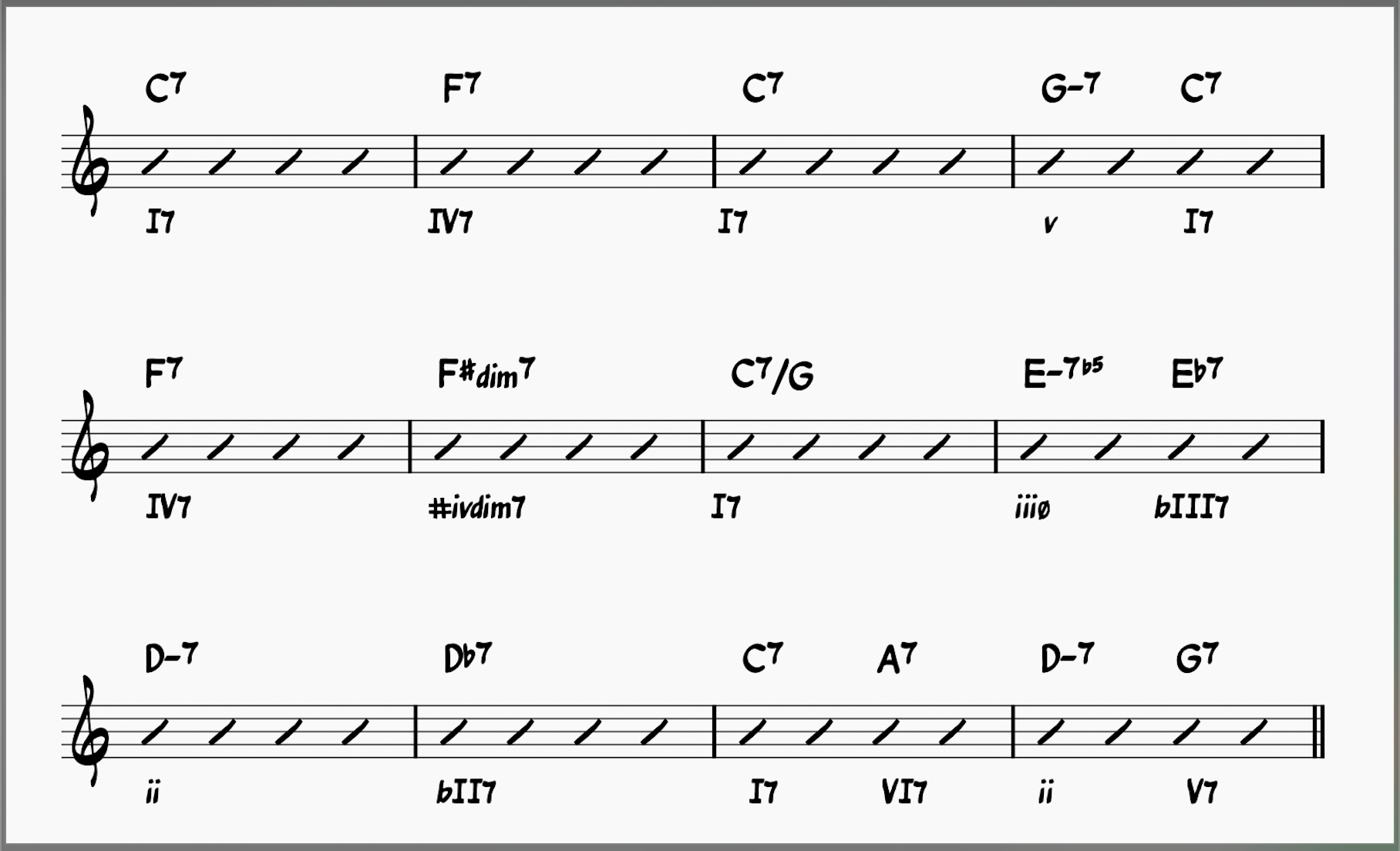
We still relate all chords to C, our tonic chord. When that tonic chord is a dominant seventh chord, we label it I7 instead of I. The same is true of the IV chord, now a IV7 chord.
Normally, the G chord is a dominant chord, but in bar four of this blues, it is a minor seventh chord. Therefore, we can label it v (or sometimes v-7) instead of V (or V7).

Even non-diatonic chords with roots outside the key, like the F#dim7 in bar six, the Eb7 in bar eight, or the Db7 in bar ten, can be labeled accordingly.
- F#dim7 is a #ivdim7 chord. Here, it functions as a diminished passing chord.
- Eb7 is a bIII7 chord (if E-7 is iii, then a major Eb chord is bIII). Here, the Eb7 functions as a tritone substitution of A7.
Db7 is a bII7 chord (if D-7 is ii, then a major Db chord is bII). Here, the Db7 is also a tritone substitution. However, this time, it is replacing a G7.
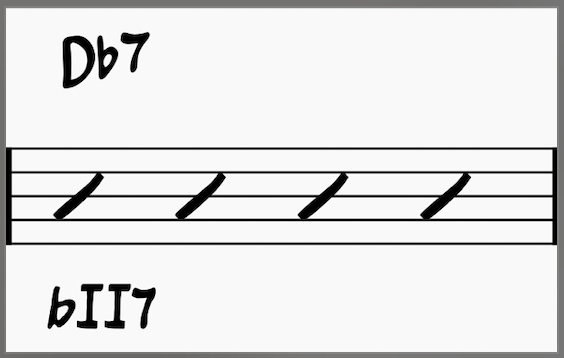
For more on chord substitutions, check out this guide exploring five common chord substitutions found in jazz. For more on borrowed harmony (or modal interchange), check out this guide on how to use modal interchange.
Now, we’re ready to tackle common jazz chord progressions!
Basic Jazz Chord Progressions in Jazz
The following fundamental jazz chord progressions make up nearly all jazz music. Learn these important jazz chord progressions first, and you’ll be well on your way to mastering all jazz tunes.
1. The Major ii-V-I (the Quintessential Jazz Chord Progression)
The major ii-V-I chord progression is the most important jazz chord progression you need to know.
This common chord progression is important in other styles of music as well, but it is the primary building block of jazz chord progressions. The major ii-V-I consists of three basic chords: a ii chord (minor seventh chord), a V chord (a dominant chord), and an I chord (a major seventh chord).
These are all diatonic chords, which we defined in a previous section.
You’ll want to spend plenty of time working on the ii-V-I chord progression in every key. Whether you play jazz guitar or piano, you should familiarize yourself with this chord progression all over your instrument, focusing on different inversions and voicings.
Even if you aren’t a jazz guitarist or pianist and play a horn, you should still know basic chord progressions on a chordal instrument. Learning these chord progressions inside and out will improve your jazz soloing skills.
Example:

In this case, we are in the key of C major. So:
- Dmin7 is the ii chord
- G7 is the V chord
- Cmaj7 is the I chord.
In total, our ii-V-I progression is Dmin7-G7-Cmaj7.
We won’t have jazz licks for all of these jazz chord progressions. However, the ii-V-I is so important that we felt obliged to provide a jazz lick.
Major ii-V-I progression Lick

Here are some other ii-V-I licks you should master.
Practice Challenges for this Jazz Chord Progression:
- Take the ii-V-I progression into all 12 keys, playing the arpeggios of each chord.
- Learn a ii-V-I lick from a favorite jazz musician or learn one of these.
- Identify each chord’s important chord tones (3rds and 7ths), and then target them when you practice improvising over this particular progression.
Here are ii-V-I chord progressions in every major key for you to practice:
C Major

F Major

B Flat Major

E Flat Major

A Flat Major

D Flat Major

F Sharp Major

B Major

E Major

A Major

D Major

G Major

2. Minor ii-V-i
This jazz chord progression has the same function as the previous major ii-V-I, but it is in a minor key. In this chord progression, the minor ii and i chords are both minor, and the V chord is a dominant chord.
In many jazz standards, major and minor ii-V-I’s are in the same song form.
Example:

The V chord can be turned into an altered chord to add harmonic tension, meaning you can add a b9, #9, or #5 (sometimes #11). We made the V as a G7(b9) chord in this case. Also, because we are implying a minor key, the minor ii chord has a flat 5th, which is diatonic in minor keys.
For more on minor keys and their relationship to major keys, check out our article on parallel and relative minor.
Practice Challenges for these Jazz Progressions:
- Seek out a tune with many minor ii-V-i’s, such as Blue Bossa, Yesterdays, or Alone Together. Find a recording you like and learn a minor ii-V-i lick by ear.
- Practice taking the minor ii-V-i chord progression through all 12 keys and play the arpeggios of each chord.
Instead of practicing each progression as an isolated progression like with the major ii-Vs, try practicing going from one key to the next in the circle of fourths.
Here are all 12 minor ii-v-i progressions in groups of four:
C minor, F Minor, B Flat Minor, and E Flat Minor
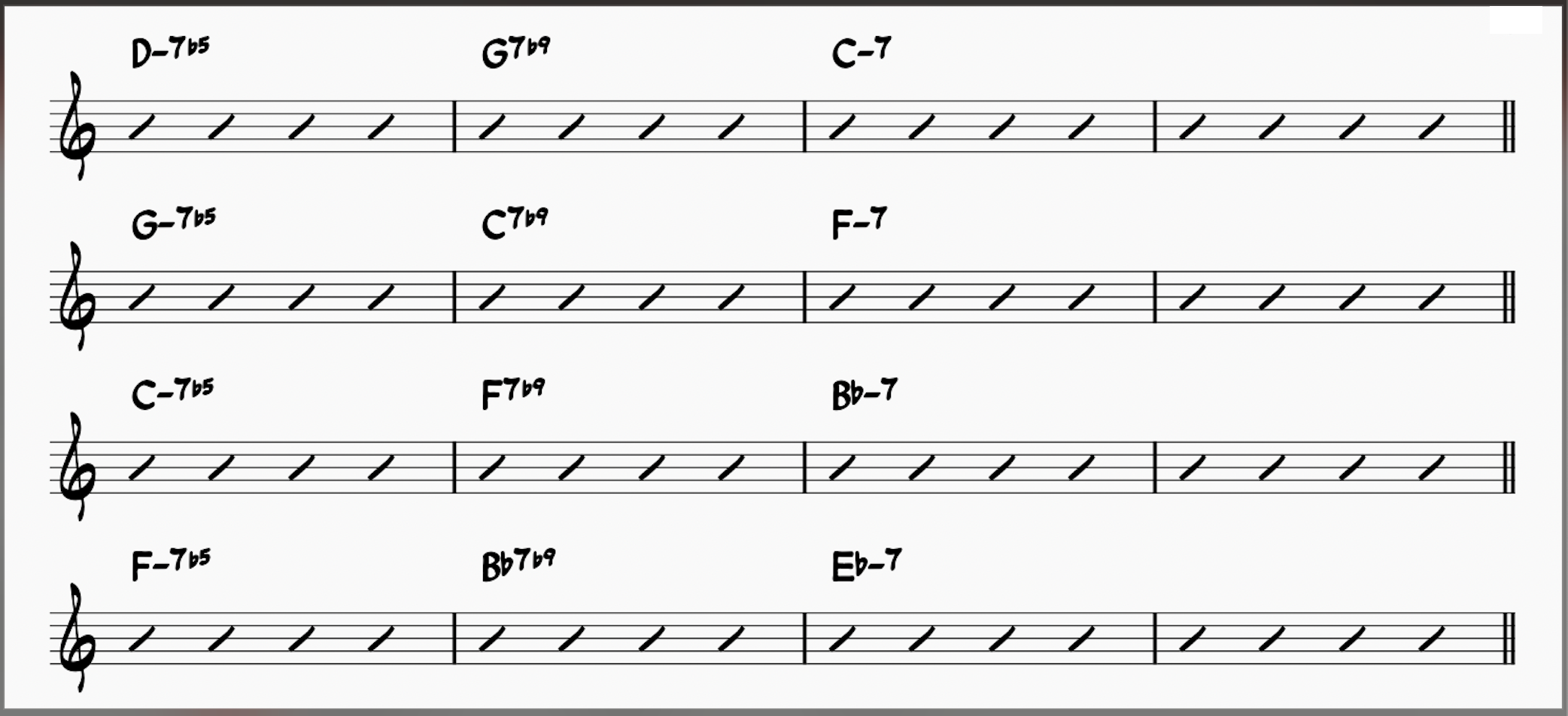
A Flat Minor, D Flat Minor, F Sharp Minor, and B Minor
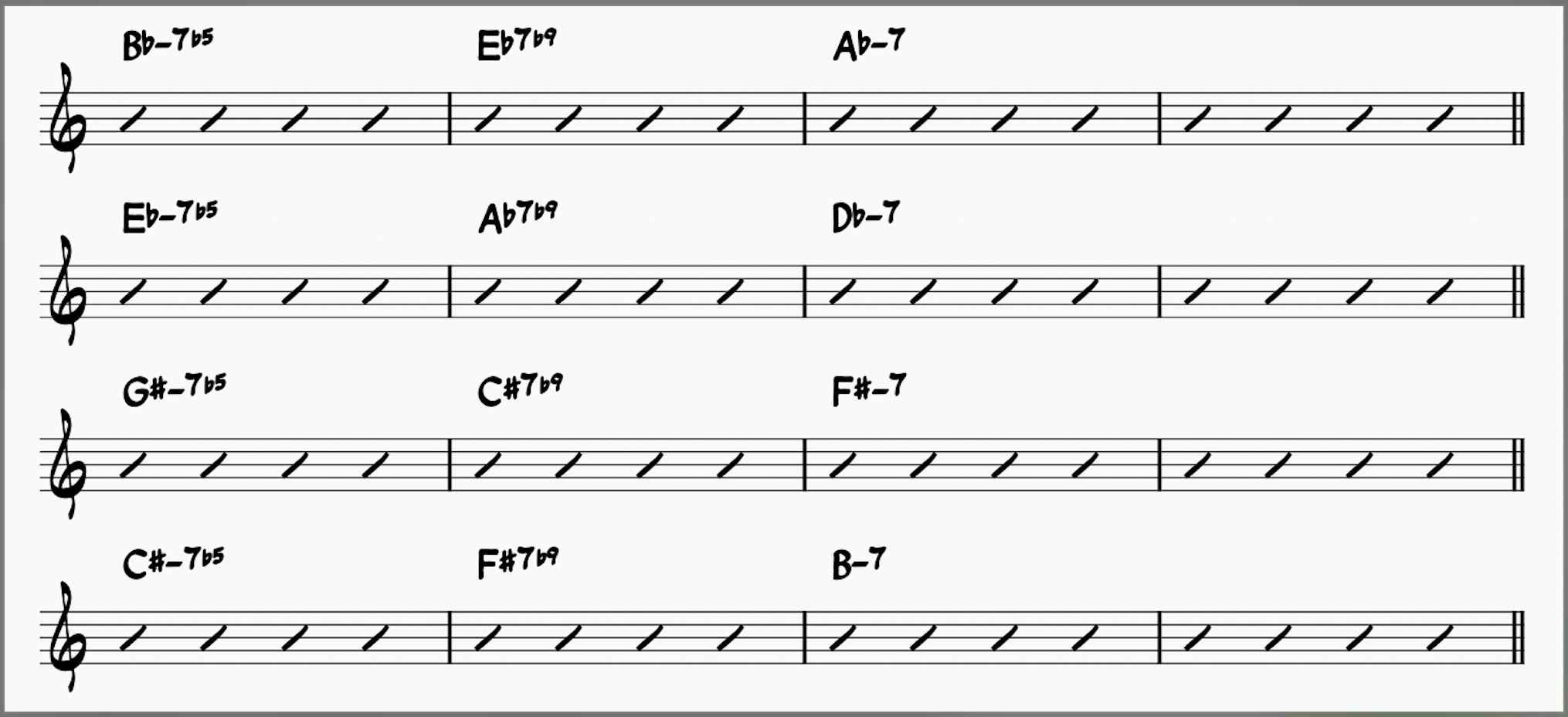
E Minor, A Minor, D Minor, and G Minor
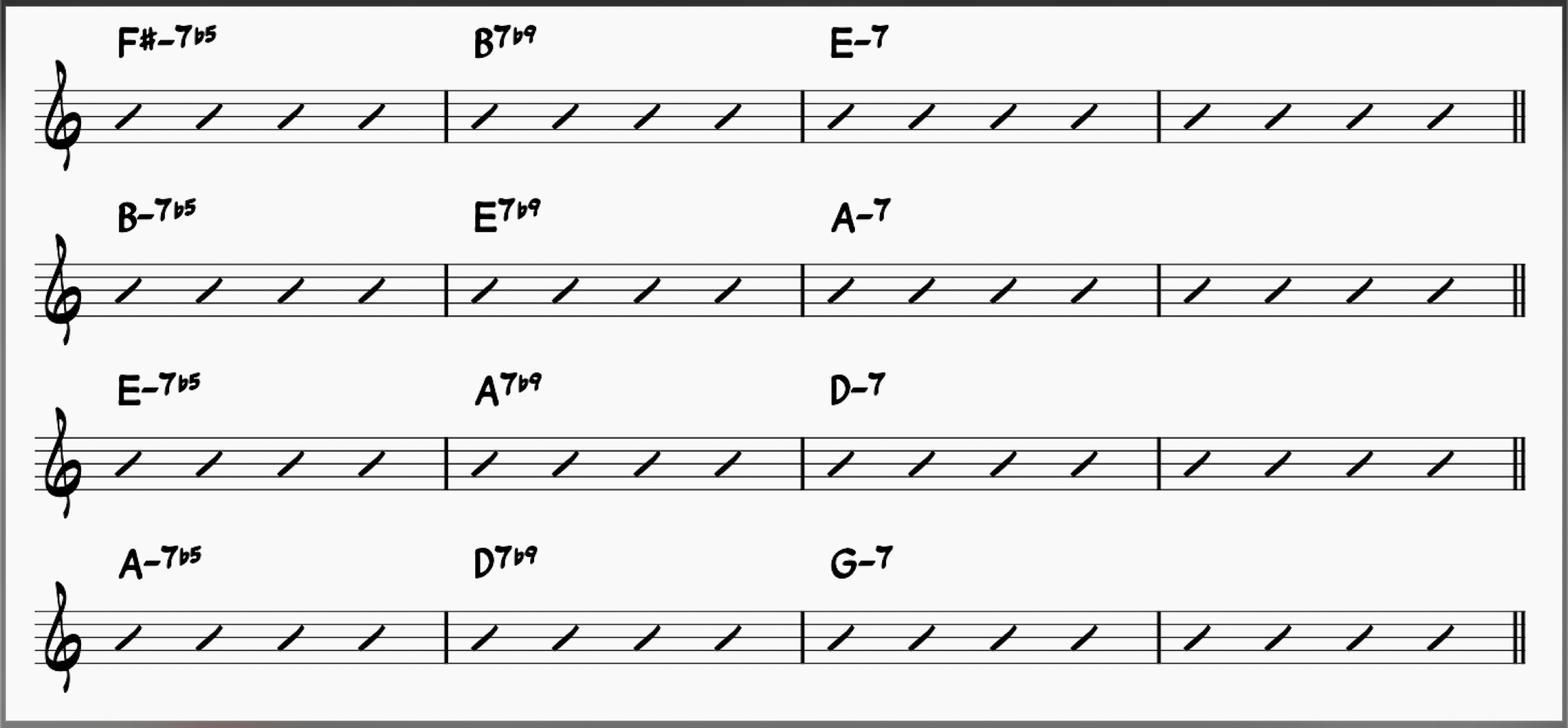
3. Major I-vi-ii-V
This jazz progression has only four chords and appears in many jazz standards. You’ll find it in any rhythm changes tune, such as the classic tune Oleo. Though this chord progression is often written into certain jazz tunes, chord players usually add it as a turn-around back to the I chord.
Example:

It’s important to note that the vi chord, to be diatonically correct, is a minor chord. However, jazz musicians will often turn it into a dominant seventh chord. In music theory, turning non-dominant chords into dominant chords is called “dominantization” or “making a chord dominant.”
This often involves altering the chord to include a major third and a minor seventh. By “dominantizing” a chord, it gains a tendency to resolve or “pull” to another chord, typically a chord a perfect fifth below (or a fourth above).
Practice Challenges:
- Learn a I-vi-ii-V lick by ear or learn one of these.
- Learn a rhythm changes tune by checking out this article.
- Practice taking the I-vi-ii-V chord progression through all 12 keys, and play the arpeggios of each chord.
4. Minor i-vi-ii-V
Let’s bring this common jazz chord progression into the minor key.
Example:

Remember that the viø chord in the minor diatonic series is borrowed from the melodic minor harmonization of 7th chords. Therefore, it is a half-diminished chord.
The challenge of this progression is learning how to improvise over two half-diminished chords in a row.
Practice Challenges:
- Learn some minor blues heads. Often, this minor chord progression is used as a turn-around.
- Work on spelling out the half-diminished chords. The Locrian mode of the major scale is an ideal choice for this chord.
For more on the modes of the major scale, check out our guide to the musical modes.
These are the basic jazz chord progressions you need to know. If you have each one of these jazz chord progressions down, you will be well on your way to dominating any jazz blues, jazz standard, ballad, or other type of jazz tune.
Common Substitutions and Chordal Movements
We should also cover a handful of important substitutions, alternatives, and add-ons to these basic jazz chord progressions. Players often change the chord qualities within the basic ii-V-I progressions and I-vi-ii-V progressions.
The basic jazz chord progressions are foundational, but they are just scratching the surface.
Here are a few you should be aware of!
5. iii replaces the I
In jazz, the iii chord, a minor seventh chord, is often replaced by the I chord, a major seventh chord. In the following example, a Cmaj7 is replaced by an Emin7.
An Emin7 chord is essentially a Cmaj9 chord without the root:

The I and the iii chords are essentially the same chord. This chord progression is known as a iii-vi-ii-V progression.

Practice Challenge:
- Review some jazz standards and look for opportunities to substitute the iii for the I. Sometimes, this won’t be appropriate, but it’s a good exercise of awareness.
6. #i° diminished replaces the VI7
A classic substitution is the #i diminished chord for the dominant VI chord. This creates a diminished passing chord that brings you chromatically to the ii chord.
This is most often seen in the context of a I-VI-ii-V progression. But when you sub the #i diminished for the VI, it becomes I-# i°-ii-V.

Why this works is a pretty hefty topic.
We cover the theory behind diminished chords in this post.
But, the basic concept is that a dominant 7(b9) chord has all the same essential chord tones as its corresponding diminished seventh chord. Therefore, diminished passing chords can be used instead of dominant chords.
Practice Challenge:
- Go through the jazz standards you know and identify VI-ii relationships. Then replace the VI with a #i diminished.
7. I-IV7-iii-VI7
Jazz musicians are always looking for different ways to cycle chords. In traditional jazz
harmony, the harmonic movement always tries to return to the I chord.
Whenever a jazz chord progression aims to return to the I chord, it’s called
a turnaround. One such popular turnaround is the I-IV-iii-VI, which cycles into the ii-V-I.

Take a look at the IV chord.
To be accurate, the IV chord would be a major 7. However, jazz musicians usually turn the IV chord into a dominant seventh chord (see “dominantization” above). The major 7 can be used but is less common. The VI chord is usually a dominant 7 in this scenario.
Practice Challenge:
- Learn the classic tune I’ve Never Been in Love Before. This jazz standard has this jazz chord progression in it.
8. Chromatic ii-V’s
Jazz musicians often utilize what are called chromatic ii-V’s. Sometimes, they are written into a composition, but jazz players usually add these to the harmony or outline them in their improvisation.
Let’s use a ii-V-I example. This is a common use of chromatic ii-V’s, but you can apply this to others when cycling in 4ths.

Practice Challenges:
- Learn Bye Bye Blackbird. This substitution is built into the composition.
- Try imposing your own chromatic ii-V’s over turnarounds in a jazz blues, a rhythm changes, or any jazz standards you know.
9. Tritone Sub of V
A tritone substitution is when you substitute a chord (usually dominant 7th) for a dominant 7th chord a tritone interval away.

Notice that a tritone sub of V in the context of a ii-V-I has the root notes moving chromatically (D-Db-C). A bass player, jazz guitarist, or pianist might play a chromatic bass line to imply this chord progression in their jazz comping.
A chromatic bass line moves from the minor ii chord through the passing chord and resolves at the target.
Practice Challenge:
- Next time you come upon a ii-V-I, play a tritone substitution in your comping or solo.
Extra Jazz Chord Progression Resources
If you need extra help mastering jazz chords and chord progressions, check out these great resources below.
General Jazz Chords/Chord Progressions Help
If you need a refresher on triads and how to practice them for maximum results, check out this practice guide. Also, check out this guide to jazz blues progressions to take what you’ve learned here and apply it to the blues.
Help for Jazz Guitarists
If you need general help getting started with jazz guitar, check out our Beginner Jazz Guitar Guide.
If you are already familiar with the basics of jazz guitar but want more help with chords and voicings, check out these resources:
Jazz Guitar Triads:
- Major Triads For Jazz Guitar
- Minor Triads For Jazz Guitar
- Diminished Triads For Jazz Guitar
- Augmented Triads For Jazz Guitar
7th Chords For Jazz Guitar:
Check out our article 20 Basic Guitar Jazz Chords for a breakdown of essential 7th chord voicings on guitar.
- Maj7 Chords For Jazz Guitar
- Min7 Chords For Jazz Guitar
- Dominant Chords For Jazz Guitar
- Half-diminished chords For Jazz Guitar
- Diminished chords For Jazz Guitar
Help For Jazz Pianists:
Check out this post on 15 essential jazz piano chords for a refresher on jazz piano voicings. Plus, here is the encyclopedia of two-hand jazz piano voicings. Finally, check out our left-hand piano voicings for ii-V-I progressions.
Want To Master Jazz Music? Join The Learn Jazz Standards Inner Circle
If you want one convenient place to master passing chords, chromatic ii-Vs, various chord voicings, many uses for diminished chords, and all the other essential aspects of jazz harmony, then you need to check out the Inner Circle.
Whether you are a jazz guitar student, aspiring trumpeter, bass player, just getting into jazz, or anything in between, the Inner Circle has all the resources, tools, and community to help you become the best jazz player you can be.
If you want to accelerate your jazz playing, jazz theory knowledge, and overall musicianship with the help of professional jazz musicians, then come see what we’re all about.
Improve your jazz playing in 30 days or less. Join the Inner Circle.




